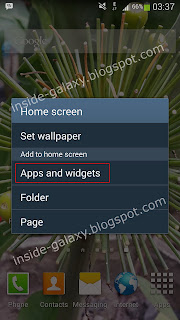See also: How to Download and Install Free Apps from the Google Play Store in Samsung Galaxy S4
You can see and access all installed apps through the application menu. By default, the apps in the application menu are displayed in the customizable 3x4 grid which will place all pre-installed apps in the first place and then the recent installed apps in the next place. The flaws of this default layout is the apps will looks like not organized well and sometimes makes us end up to spend more time to swipe back and forth in the apps menu to find certain apps. So, if you don't like this default, you can change the way of the application menu to arrange all apps by changing the view type option available in here.
How to change view type in the applications menu?
Below are the steps to do so:
- Go to Apps through Home screen.
- Tap the Menu key then select View type.
- You'll see three options available in the pop up menu. They are:
- Customizable grid: This is the default view type used by the apps menu which will display the apps in the 4x5 grid layout. When you choose this option, you will allowed to rearrange the apps position as your wish as well as add a new page if there's no more room available to place the new installed apps.
- Alphabetical grid: This option will display the apps in the 4x5 grid alphabetically
- Alphabetical list: This option will display one app per row in the vertical list alphabetically. When you choose this option, you can jump to another apps easily by tapping the letter category displayed at the right side of the screen, for instance when you tap the letter A then all apps which is beginning with the letter A will be displayed in the screen.
- Select the desired view type you wish to use. If the radio button next to the option shows green means the option is selected.
- Now, the apps will be sorted according to the view type you've just selected.
As a note, each view type option has their own advantage and disadvantage, so choose the best one that suit your needs. Choose the right view type will help you to improve your experience while you're in the application menu.
































